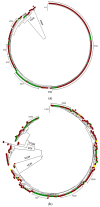Cryptococcus neoformans and Cryptococcus gattii Species Complexes in Latin America: A Map of Molecular Types, Genotypic Diversity, and Antifungal Susceptibility as Reported by the Latin American Cryptococcal Study Group
- PMID: 33918572
- PMCID: PMC8069395
- DOI: 10.3390/jof7040282
Cryptococcus neoformans and Cryptococcus gattii Species Complexes in Latin America: A Map of Molecular Types, Genotypic Diversity, and Antifungal Susceptibility as Reported by the Latin American Cryptococcal Study Group
Abstract
Cryptococcosis, a potentially fatal mycosis, is caused by members of the Cryptococcus neoformans and Cryptococcus gattii species complexes. In Latin America, cryptococcal meningitis is still an important health threat with a significant clinical burden. Analysis of publicly available molecular data from 5686 clinical, environmental, and veterinary cryptococcal isolates from member countries of the Latin American Cryptococcal Study Group showed that, as worldwide, C. neoformans molecular type VNI is the most common cause of cryptococcosis (76.01%) in HIV-infected people, followed by C. gattii molecular type VGII (12.37%), affecting mostly otherwise healthy hosts. These two molecular types also predominate in the environment (68.60% for VNI and 20.70% for VGII). Among the scarce number of veterinary cases, VGII is the predominant molecular type (73.68%). Multilocus sequence typing analysis showed that, in Latin America, the C. neoformans population is less diverse than the C. gattii population (D of 0.7104 vs. 0.9755). Analysis of antifungal susceptibility data showed the presence of non-wild-type VNI, VGI, VGII, and VGIII isolates in the region. Overall, the data presented herein summarize the progress that has been made towards the molecular epidemiology of cryptococcal isolates in Latin America, contributing to the characterization of the genetic diversity and antifungal susceptibility of these globally spreading pathogenic yeasts.
Keywords: Cryptococcus; Latin America; MLST; antifungal susceptibility; cryptococcosis; molecular types.
Conflict of interest statement
The authors declare no conflict of interest.
Figures


References
-
- UNAIDS. [(accessed on 13 January 2021)]; Available online: https://www.unaids.org/sites/default/files/media_asset/UNAIDS_FactSheet_....
Publication types
LinkOut - more resources
Full Text Sources
Other Literature Sources

